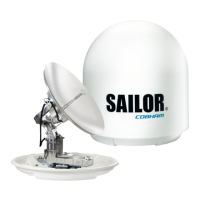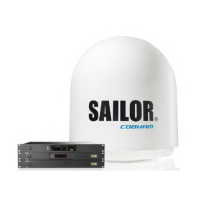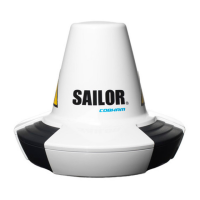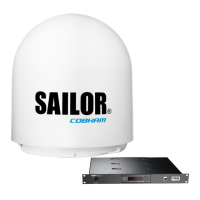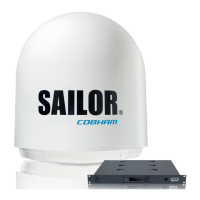Do you have a question about the COBHAM SAILOR XTR Ku and is the answer not in the manual?
Overview of the SAILOR XTR Ku system, operating in the Ku-band for bi-directional IP data connections.
Key features including single cable, VSAT modem support, gyro-free operation, and Ku-to-Ka band conversion.
Detailed description of the Above Deck Unit (ADU), including its stabilization and weight.
Description of the Below Deck Unit (BDU), its interfaces, and functions.
Lists available system variants, part numbers, and optional accessories for the SAILOR XTR Ku.
Lists included items and guidance for inspecting units for damage after unpacking.
Factors to consider for optimal ADU placement, including general guidelines and obstructions.
Safety distances required to avoid microwave radiation hazards during operation.
Setting up blocking zones to prevent ADU transmission in specific areas.
Prerequisites and step-by-step instructions for installing the Above Deck Unit (ADU).
Steps for installing the Below Deck Unit (BDU) into a 19-inch rack.
Detailed overview of the BDU's connector panel, including AC input and ADU connectors.
Description of Rx/Tx connectors for modems and the NMEA 0183 RJ-45 connector.
Details on RS-232, RS-422 connectors, and the BDU's LAN connectors.
Guide to using the built-in web interface for system setup and configuration.
Configuration of VSAT profiles, including modem and satellite data.
Configuring static IP, DHCP client, DNS, and gateway settings for network connectivity.
Setting the heading and position modes before starting the calibration procedure.
Setting up blocking zones to optimize performance and ensure safety.
Managing software, configurations, and performing system service tasks.
Detailed steps for azimuth and cable calibration essential for system operation.
Description of the sequence of operations during system startup.
Checklist to verify the correct installation of the antenna system.
Checklist to verify the installation of the BDU, connectors, and wiring.
Checklist for performing a functional test of the system in harbor.
Using BITE functions and LEDs for fault diagnostics and status indication.
General guidelines and initial checks for troubleshooting system faults.
Steps to gain temporary administrator access if the password is forgotten.
Detailed technical specifications for the SAILOR 1000 XTR Ku ADU.
Detailed technical specifications for the SAILOR 800 XTR Ku ADU.
Detailed technical specifications for the SAILOR 600 XTR Ku ADU.
Detailed technical specifications for the SAILOR XTR Ku BDU.
Features and benefits of the SAILOR XTR Ku Dual antenna solution.
Overview of the dual mode antenna system architecture with Master/Slave BDU setup.
Step-by-step instructions for configuring the Slave BDU in a dual antenna setup.
A flow chart illustrating the process of installing the dual antenna solution.
Strategies to optimize VSAT modem performance during signal blockage.
Detailed guide for setting up the OpenAMIP protocol between BDU and VSAT modem.
Instructions for connecting and configuring the SatLink 2910 VSAT modem.
Methods for connecting to the system's command line interface via SSH or Telnet.
An alphabetical reference list of commands for the command line interface.
Importance of grounding for safety, ESD protection, and RF interference mitigation.
Instructions for properly grounding the BDU to the ship's hull or structure.
Methods for grounding the ADU, including alternative options for different hull types.
How the SAILOR XTR Ku detects and reports system events and errors.
A detailed list of event IDs, modules, types, descriptions, and explanations for troubleshooting.
Examples of satellite data including coverage, frequency, and polarization for calibration.
EU Declaration of Conformity for RED directive, including equipment included.
| Frequency Range (Tx) | 13.75 - 14.5 GHz |
|---|---|
| Frequency Range (Rx) | 10.7 - 12.75 GHz |
| Weight | 85 kg |
| Azimuth Range | Unlimited |
| Power Consumption | 150 W |
| Operating Temperature | -25°C to +55°C |
| Humidity | Up to 100% condensing |
| Antenna Diameter | 1.0 m |
| Gain (Rx) | 38.3 dBi @ 11.70 GHz |
| Tracking | Automatic |
| Power Supply | AC 100-240V, 50/60 Hz |
| Antenna Type | Ku-band maritime VSAT antenna |
| Polarization | Linear, cross-pol |

